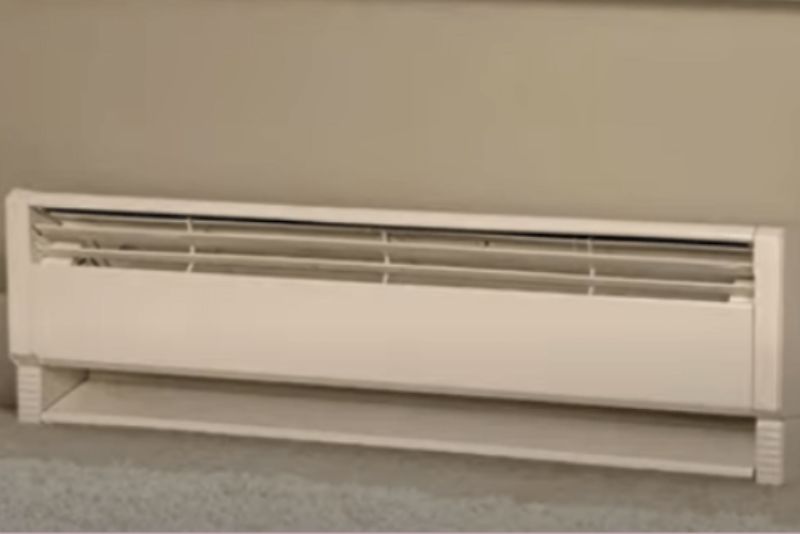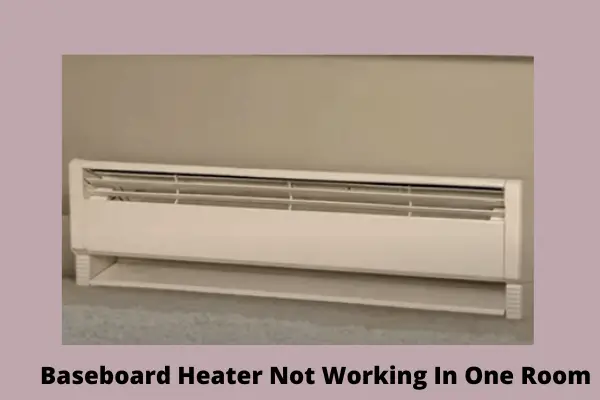Your baseboard heater not working in one room can be caused by a frozen line, airlocks, broken circulator pump, dirt buildup due to lack of cleaning, lack of airflow, tripped circuit breaker, lack of electrical supply, thermostat not working, and heating element not working.

Keep reading our baseboard heater troubleshooting guide to fix your issue ASAP.
Table Of Contents
- Baseboard Heater Not Working In One Room [9 Easy Fixes]
- 1. Frozen Line
- 2. Airlocks
- 3. Broken Circulator Pump
- 4. Dirt Buildup
- 5. Lack of Airflow
- 6. Tripped Circuit Breaker
- 7. Lack Of Electrical Supply
- 8. Thermostat Not Working
- 9. Heating Element Not Working
- FAQs:
- How long do baseboard heaters last?
- How much does it cost to replace baseboard heaters?
- What is cheaper baseboard heat or forced air?
- Can you adjust the baseboard heating?
- What are the pros and cons of baseboard heating?
- Conclusion
Baseboard Heater Not Working In One Room [9 Easy Fixes]
In this section, we will take a detailed look at the causes of your baseboard heater not working in one room and provide you with step-by-step instructions on how to solve each problem.
Note: You can also read how to convert steam heat to Baseboard.
1. Frozen Line
This is applicable only to a hydronic baseboard heater. If the water inside is frozen, your heater won’t heat up as these heaters work by first heating up the liquid inside.
This heated water then transfers heat throughout your home. So, if one pipe is frozen, that could be why that room won’t heat up.
Solution:
Locate the zone where the line is frozen. Connecting a hose from your washing machine to the purge supply while increasing the boiler pressure to about 24 PSI and setting the thermostat at 200° F will force the flow of water and heat.
Now close off all other zones except for the one you want to thaw. Now, when your thermostat calls for heat, the circulator pump will be hounding the frozen zone. At this point, all you need to do is wait for the heat to get to the frost and start melting.
There are also tools that are designed to de-freeze pipes. If you cut the return and supply before zipping some current through the frozen line with the tool, the line will heat up too. Some people also use torches to chase the ice till it melts.
2. Airlocks
When vapor gets stuck in a heating system and blocks water from entering the radiator, an airlock might happen, leaving the appliance cold.
While the water in your baseboard heater is heated, it might occasionally produce too much water vapor. Due to the lower density of vapor than water, this gas normally climbs to the top of your system.
This is referred to as an airlock, and it can lead to a variety of issues with your baseboard heater.
Solution:
Take a glance at the baseboard’s sides. Is there a tiny silver fitting in the center with a square head or a screw slot? This “coin vent” is utilized to release air that has built up in the baseboard.
If your basement has valves to segregate areas, close the valves to the baseboard heater, bleed out air until water appears, open the valve, close the valve on the opposite side, and bleed once more.
Check your boiler’s pressure once more, then try opening all the valves to see what occurs. If the issue persists, it’s time to find a nearby contractor.
3. Broken Circulator Pump
The blower fan in a furnace fulfills the same function as the circulator pump on a boiler: it distributes whatever the system heats, in this instance hot water is sent via lines to baseboard heating or radiators.
If the pump fails, water will still move through the boiler’s system through convection, but it will move very slowly. You could not be obtaining heat in a room because of this decrease in heating power.
Solution:
Here’s how you replace the circulator pump. You should only try to do this yourself if you have experience with doing repairs. Otherwise, it is too risky.
- Turn off the fuel, water, and electricity to the pump that services the boiler or water heater. Turn off the circulation pump’s electricity.
- Using the 6-in-1 screwdriver, remove the electrical cover from the pump’s top cartridge. Electrical lines should be disconnected from the pump.
- Valve the circulator pump off if you can. Use the boiler drainage at the lower end of the boiler and the hose to drain down the boiler if valves weren’t included during the original installation.
- The four bolts keeping the circulation pump in place must be loosened and removed, then the pump must be taken out. Uninstall the motor assembly by using the proper size Allen key.
- Use the included gaskets to install the replacement motor assembly in accordance with the manufacturer’s guide. Reverse Steps 1 through 8 and then restart the system by following the Operating Instructions provided by the specific boiler or water heater manufacturer. Inspect for leaks.
4. Dirt Buildup
Too much grit or dust accumulation in the vent can reduce the overall functionality of your baseboard heaters.
Such heating units are prone to attracting dust and filth due to their location. This dirt absorbs the majority of the heat generated by the heater.
Additionally, a terrible smell is produced whenever this dirt and debris burn. Carbon monoxide basically smells like this.
Solution:
If you can smell anything suspicious do the following.
- First, turn off the heater, then wait for it to cool.
- Clean the vent’s dirt by wiping it with a clean, wet cloth.
- Activate the heat and check to see if the odor is still present.
- If you have a carbon monoxide detector in your house, make sure it is working.
- Obtain a professional if the odor continues.
Make sure to keep your baseboard heater clean. Just clean them every few months without forgetting. You can watch this video to help you with the process.
5. Lack of Airflow
Check the vents in case your electric baseboard heater doesn’t seem to be working. Vent obstructions make it difficult for the airflow to effectively distribute heat. A variety of causes can be behind the obstructed vents.
The linked valves inside the vents, for instance, any solid items at the front of the vent, foreign objects stuck in the vent, etc.
If there is insufficient lubrication to maintain the valves’ separation, the heater’s internal valves may become blocked. Moreover, the vent may become blocked with dirt and debris, which will reduce the amount of heat produced.
Solution:
You must allow the heater to breathe to resolve this problem. Here’s what you can do in this situation is:
- Ensure that nothing is close to the vent.
- Examine the vent to determine if anything is blocking it.
- Keep all things, no matter how big or little, away from the device.
- Lubricate the valves appropriately.
- Verify whether there is a consistent supply of electricity.
By carrying out these actions, you can be certain that nothing is obstructing the vent paths.
6. Tripped Circuit Breaker
If the baseboard heater circuit breaker trips right away, this could be the cause of one zone of your baseboard heaters not working. You most likely have a short in the baseboard heater’s system someplace.
The circuit breaker itself may also be at fault. Short circuits in the system might be caused by bad wiring of the circuit breaker.
Solution:
In this situation, you essentially need to update the circuit breaker’s wiring. You might also try swapping out the entire wiring or replacing the total circuit breaker unit if it’s faulty.
Another effective solution to this problem is to replace the fuse. Here’s how to check the system:
- Make sure you first switch off the electricity. To cut the electricity, use the circuit breaker in the breaker box.
- Examine the electrical components and the wire connection on the baseboard heaters.
- Follow the electrical panel’s wiring directions. Check the route it took to reach the thermostat and the circuit breaker.
- Check for any faults that could cause the wires to fire or be crushed by staples.
- Make sure the cables are in good shape. Make sure the wires are secure and connected to the thermostat appropriately.
- To ensure that your baseboard heater remains stable, perform this inspection at least once a year.
7. Lack Of Electrical Supply
If there is not enough electricity available, baseboard heaters may not produce enough heat. A baseboard heater warms the air passing it over a number of metal fins.
An electric current is used to warm these fins. In essence, this heat creates the warmth we need. As a result, it is clear that electricity is essential to the operation of a baseboard heater.
Your heater doesn’t function effectively because of the poor heat production caused by an inadequate electricity supply.
Solution:
Follow the steps below to resolve this issue:
- Examine the label and confirm the total amperage load of the circuit breaker.
- Verify that the breakers range from 20 to 30 amps.
- Check the room’s wall outlet if the circuit breaker is below that.
- For an outlet inspection, contact an electrician.
- After allowing the circuit to cool, you can try turning it on and off again.
- If nothing functions, switch out the circuit breaker.
- Your baseboard heater will work properly once again if you follow these easy measures.
8. Thermostat Not Working
In case your heater’s thermostat is not in perfect working order, a baseboard heater might not function. We essentially mean a clogged contact in the thermostat when we say it has a defective thermostat.
Even if you try to switch the heater off, such a malfunction keeps it running continuously. It implies that the thermostat on your baseboard heater is jammed. Your electric bill may go up as a result.
Solution:
Here’s how you solve this issue:
- First, turn off the gadget and give it time to cool
- Check to see whether the thermostat is set to the proper temperature.
- If the temperature remains high despite being turned off for a long time, check the thermostat for obstructions and clear them.
- If this doesn’t fix the issue, switch the thermostat.
- This is the ideal solution for a broken thermostat.
9. Heating Element Not Working
Your electrical baseboard heater is likely in need of a new heating element if none of the issues mentioned up to this point apply to it. This includes the fins.
If it hasn’t been maintained, an electric baseboard heater’s lifespan will be substantially shorter even though it may last up to 20 years.
An outdated heating element may be significantly less efficient and effective. As a result, the baseboard heater might not heat your room’s air to the desired level.
Solution:
Using an extremely outdated electric baseboard heater isn’t practical. Despite its low performance, it will use a lot of electricity.
Hydronic baseboard heaters could be the answer. You can purchase replacement fins again for the hydronic system if the water- or oil-filled tubes are functioning properly. So, when weighing your options, think about visiting a technician.
FAQs:
How long do baseboard heaters last?
Before wearing down and failing, typical baseboard heaters typically provide their owners with service for 15 to 25 years. Life expectancy varies according to a number of variables, including quality, typical external temperatures, and thermostat adjustments.
How much does it cost to replace baseboard heaters?
Electric baseboard heater installation typically costs between $390 and $1,190, with a $780 average cost. Baseboard heaters can cost $25 to $200 without labor, and electric wall heaters can cost between $60 and $120.
What is cheaper baseboard heat or forced air?
Baseboard heating is more affordable to install, while forced air heat is more economical for large spaces. In order to assist you in making the best choice, this article will examine both heating methods in more detail and compare them using a number of criteria.
Can you adjust the baseboard heating?
If your baseboard heater has a knob, all you need to do to change the temperature is turn the knob to lower temperatures counterclockwise and the higher setting clockwise respectively.
What are the pros and cons of baseboard heating?
Baseboard heaters have a drawback when it relates to heat-up time and achieving your desired temperature, despite their superior energy efficiency. On the plus side, these systems deliver longer-lasting heat and continue to maintain a comfortable temperature even after the thermostat is switched off.
Conclusion
Hopefully, with the help of our guide, you could fix your baseboard heater not working in one room. We recommend you don’t try to do repairs that are too difficult for you. It is not worth the risk of ruining your heater permanently. Call a professional if needed.

